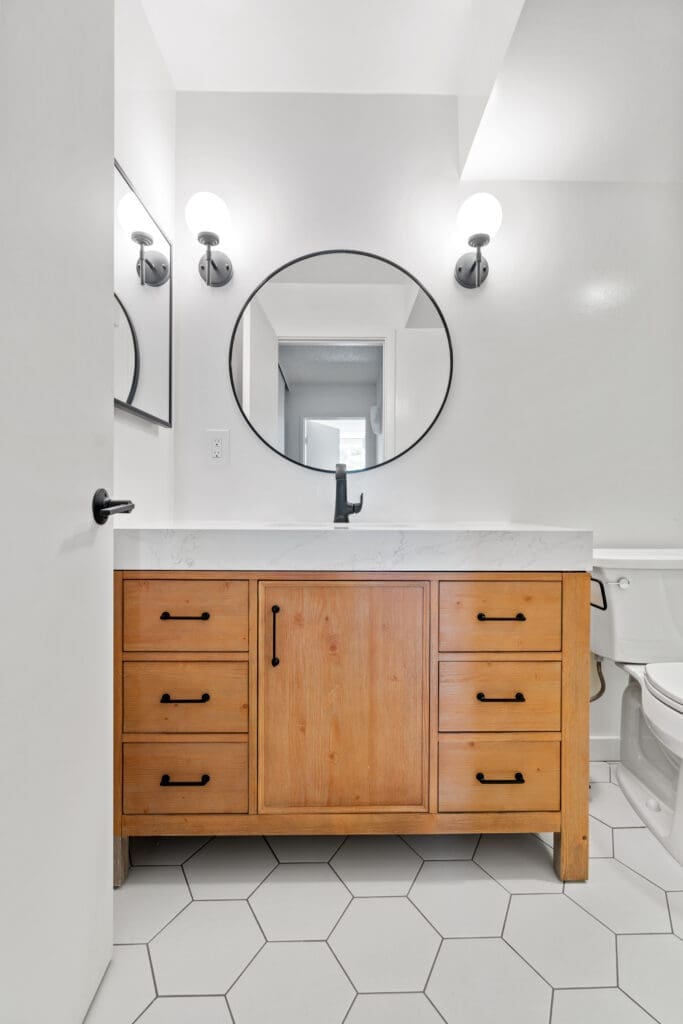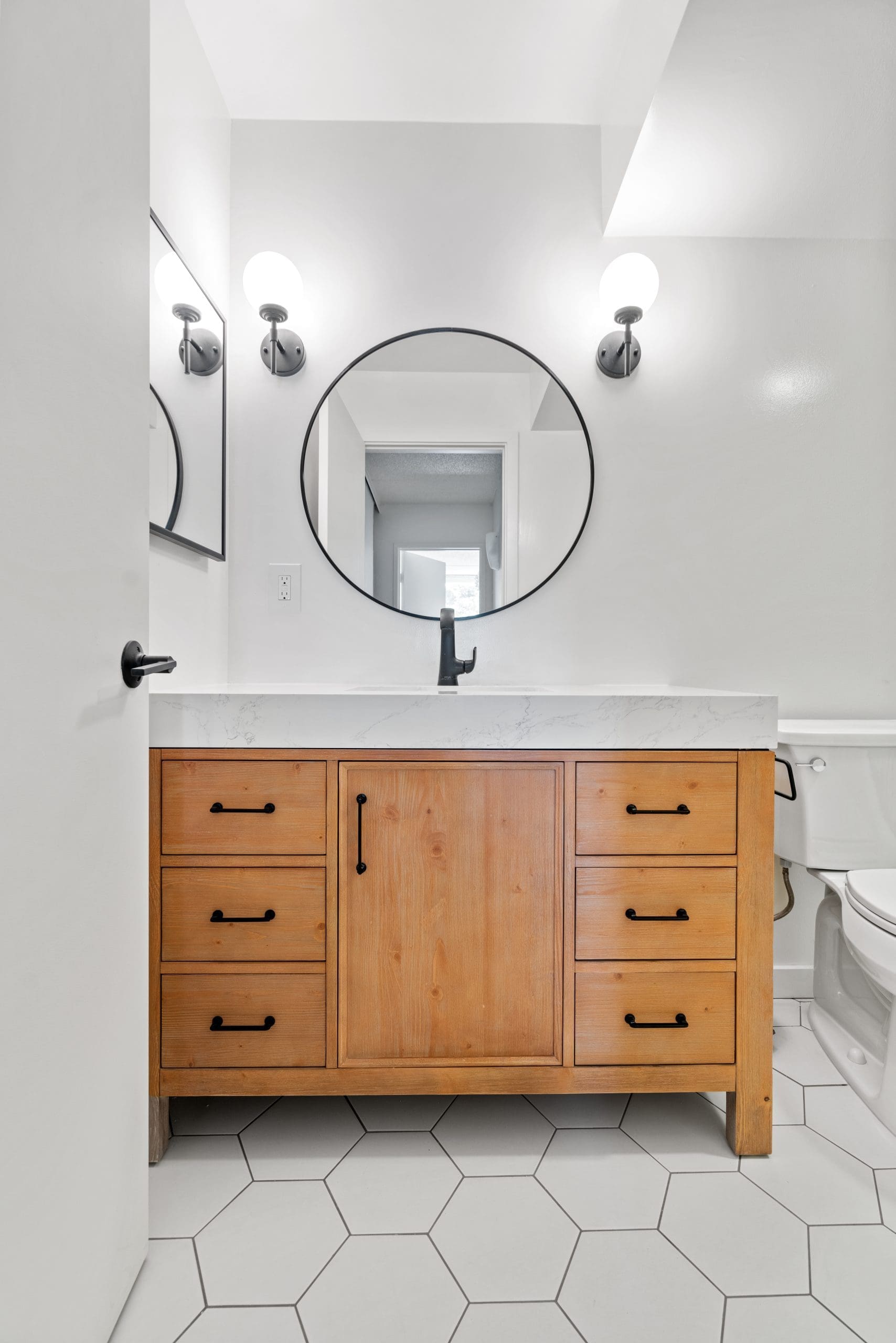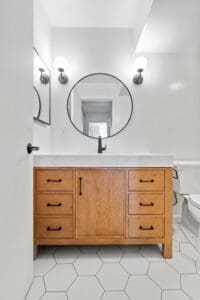Ditch the Tub? Why Bath-to-Shower Conversions Are Our New Obsession (And Yours Should Be Too!)
Alright, let’s be brutally honest for a second. When was the last time you actually used that giant soaking tub taking up prime real estate in your bathroom? Be honest! For most of us, it’s become a glorified laundry hamper or a dusty shrine to good intentions we never quite followed through on. Meanwhile, that quick, refreshing shower? That’s the daily workhorse, the true MVP of our morning routines. If this sounds painfully familiar, my friend, you might be prime candidate for a bath-to-shower conversion. And trust us, we’ve seen this lightbulb moment happen countless times for homeowners right here in the Bay Area.

We get it. The idea of ripping out a perfectly good bathtub can feel… drastic. Maybe a little scary? But hear us out. Converting that underutilized tub space into a spacious, luxurious, functional shower isn’t just a trend; it’s often a downright brilliant lifestyle upgrade. It’s about reclaiming your bathroom for what you actually do every single day. Forget the awkward climb-over; imagine stepping effortlessly into a generous, beautifully tiled shower enclosure. Sounds pretty good, right? Let’s dive into why this might be the smartest move for your home and sanity.
Why Swap the Soaker for a Super Shower?
Seriously, why are so many folks in Walnut Creek, Danville, Oakland, and across Contra Costa County making this switch? It’s not just about following the crowd. There are some rock-solid reasons:
- Space & Accessibility: This is the biggie. Tubs are space hogs. Replacing one with a well-designed shower instantly makes your bathroom feel bigger. No more squeezing past the tub edge! Plus, a low-threshold or curbless shower is a game-changer for accessibility – whether you’re planning for the future, have mobility concerns now, or just appreciate not having to hurdle a barrier first thing in the morning. Safety first, comfort always.
- Pure, Unadulterated Luxury: Let’s face it, a cramped shower stall wedged next to a tub is hardly a spa experience. A conversion lets you design a shower haven. Think multiple showerheads (rainfall, anyone?), built-in benches, chic niches for all your potions and lotions, and stunning tile work from floor to ceiling. It transforms a purely functional corner into a daily indulgence. Who needs a fancy spa membership when your own bathroom feels this good?
- Practicality Wins: For busy households, especially those without small kids needing tubs, a shower is simply more practical. Faster, more efficient, and easier to keep clean (goodbye, grimy tub ring!). It aligns perfectly with modern living.
- Value Boost (Done Right): Bold: A high-quality, beautifully executed bath-to-shower conversion is often viewed as a significant upgrade by potential buyers. While removing the only tub in the house can sometimes be a negative, converting a secondary bathroom or a rarely used tub is frequently seen as a major plus, especially with the aging-in-place trend. It signals a modern, well-maintained home.
Okay, But What About Resale? The “Only Tub” Dilemma
This is the question we hear all the time. “Won’t removing the tub hurt my home’s value?” Look, it’s a valid concern, and the answer is: It depends.
- The “Only Tub” Rule: If this is the one and only bathtub in your house, removing it entirely can potentially limit your buyer pool down the line, especially families with young kids. We generally advise keeping at least one tub somewhere in the house.
- Secondary Baths? Game On! Converting the tub in a hall bathroom, guest bath, or primary ensuite (especially if you have another tub elsewhere) is usually a fantastic idea. It modernizes the space and caters to the vast majority who prefer showers.
- Think Long-Term & Luxury: Even in the primary bath, if you design a truly spectacular, accessible shower experience (think spacious, curbless, with high-end finishes), it can absolutely be a major selling point, appealing to empty-nesters or those prioritizing luxury and ease.
The Moral? Don’t automatically ditch your only tub without careful thought. But for secondary baths, or if you’re crafting an exceptional primary shower oasis and have another tub, go for it! It’s a smart, modern upgrade. Need help figuring out what’s right for YOUR home? That’s exactly the kind of expert advice a seasoned bathroom renovation contractor like us provides.
Planning Your Perfect Shower Sanctuary: It’s More Than Just Ripping Out the Tub
Hold your horses before you grab the sledgehammer! A successful conversion requires some solid planning. This isn’t just a demolition job; it’s a precision remodel. Here’s what we always consider:
- Size Matters (A Lot): How much space are you really gaining? We measure meticulously. Are we keeping the same footprint, or can we expand slightly? Every inch counts when designing comfort.
- Layout & Flow: Where will the shower door swing? How does it interact with the vanity and toilet? We sketch it out to ensure the new layout feels open and functional, not cramped. Awkward door swings are the worst, right?
- Shower Type Showdown: What kind of shower are you dreaming of?
- Standard Alcove: Fits neatly into the old tub space, typically with three tiled walls and a glass door/front. Efficient and common.
- Neo-Angle: Great for corner installations, maximizing space visually.
- Curbless/Walk-In: The ultimate in accessibility and sleek, modern style. Requires careful sloping of the floor (more on that below!).
- Custom Shaped: Got a unique space or grand vision? We can build something truly bespoke. Custom remodels are our jam!
- The Drain & Slope Secret: This is CRITICAL, and where DIY often goes spectacularly wrong. Water must flow effectively to the drain. Converting a tub to a shower means:
- Moving the Drain: Tub drains are usually near one end; shower drains need to be centered or positioned optimally for the new shower pan.
- Creating the Pitch: The floor needs a precise slope (minimum 1/4″ per foot) towards the drain. For curbless showers, this slope often needs to start outside the shower area, requiring careful planning of the entire bathroom floor. Mess this up, and you get puddles… or worse, leaks. Not cool.
- Waterproofing is NON-NEGOTIABLE: Seriously. This is the invisible shield protecting your home. We don’t just rely on the tile. Modern systems involve specialized membranes (like Schluter Kerdi, Wedi, or liquid-applied) applied meticulously over the studs and sloped pan before tile even goes on. Bold: Skimping here is asking for catastrophic (and expensive) water damage down the road. This is why hiring a general contractor or expert bathroom remodeling team matters.
Comparing Your Shower Base Options
| Feature | Traditional Mortar Bed (Mud Pan) | Pre-Sloped Foam Pan (e.g., Schluter, Wedi) | Tiled Floors (Curbless) |
|---|---|---|---|
| Cost | Moderate (labor-intensive) | Higher (material cost) | Highest (complex prep) |
| Installation Time | Longer (curing time) | Faster | Longest |
| Weight | Heavy | Very Light | Varies |
| Precision Slope | Highly customizable | Perfect, consistent slope | Requires expert mud bed |
| Best For | Complex shapes, retrofits | Most standard conversions, DIY-friendly* | Seamless, modern looks |
| Waterproofing | Membrane required | Integrated or membrane required | Membrane critical |
| Our Preference | Solid, time-tested | Excellent balance of speed & precision | Ultimate luxury look |
(*DIY-friendly with proper knowledge, but we always recommend pro waterproofing!)
The Nitty-Gritty: What Actually Happens During the Conversion?
Okay, so you’re convinced. What’s the process look like when you work with a pro remodeling company like us? Here’s the typical flow:
- The Deep Dive (Consultation & Design): We chat about your dreams, needs, and budget. We measure everything. We discuss layout, shower type, fixtures, tile, glass – all the fun stuff! We help you navigate choices and avoid costly pitfalls.
- Demolition Day (Controlled Chaos!): Out comes the old tub, surround, and often the wall materials down to the studs around the shower area. We protect the rest of your house like it’s the crown jewels. Dust happens, but we contain it fiercely.
- The Guts: Plumbing, Drainage & Framing: This is where the magic (and expertise) starts. We relocate the drain to its optimal new position. We adjust water supply lines for your fancy new shower valves and heads. We frame any new walls or openings needed. Bold: Getting the plumbing and slope perfect here is absolutely fundamental.
- Building the Foundation: The Pan & Waterproofing: Whether it’s a traditional mud pan or a modern foam system, we build the sloped base. Then comes the superhero layer: the waterproofing membrane. Every seam, corner, and penetration is meticulously sealed. We often do a flood test – filling the pan with water to check for leaks before anything gets covered up. Peace of mind? Priceless.
- Tile Time (Where Beauty Emerges): Walls, floor, niches – it all gets covered in your chosen tile. This is where your vision starts becoming reality. Precision cutting and layout are key for a flawless finish. Grout color matters more than you think!
- Finishing Touches: Fixtures, Glass & Glory: The shower valve, trim, showerheads, and hand shower get installed. The beautiful glass enclosure goes up. We install accessories like towel bars, the toilet paper holder (finally, in the right spot!), and vanity lights. The details make it sing.
- The Big Reveal (Cleanup & Walkthrough): We clean up like we were never there (well, almost… it’s construction!). Then we walk you through your stunning new shower, explaining how everything works and caring for your beautiful new surfaces.
FYI, the complexity of moving plumbing, especially the drain, and the critical waterproofing stage are the biggest reasons why this isn’t typically a beginner DIY project. Getting it wrong is expensive to fix. Just saying! 🙂
Let’s Talk Turkey: Bath to Shower Conversion Cost
Alright, the question burning a hole in your pocket: “How much is this gonna cost?” We wish we could give you one neat number, but it’s like asking “How much does a car cost?” A basic compact sedan is wildly different from a luxury SUV!
What Drives the Price?
- Scope & Complexity: Simple alcove swap? Moderate. Moving drains and walls significantly? More complex = higher cost. A huge, curbless shower with multiple heads and exotic tile? That’s luxury home renovations territory.
- Materials: This is a HUGE variable.
- Tile: Basic ceramic vs. premium marble or large-format porcelain? Massive price difference.
- Fixtures: Standard chrome from a big box store vs. premium digital shower systems? Chalk and cheese.
- Shower Base: Prefab acrylic pan vs. custom tiled pan? Different leagues.
- Glass Enclosure: Standard framed vs. minimal unframed? Adds up.
- Labor: Skilled labor for plumbing, tile setting, glass installation, and waterproofing is a significant portion of the price. Quality craftsmanship isn’t cheap, but it lasts.
- Location: Yes, working in the Bay Area (especially Walnut Creek, Danville, Oakland) often carries a different cost structure than other regions. Permits, labor rates, material availability – it all factors in.
Ballpark Figures (Because You Want a Number!):
- Basic Conversion (Alcove, Standard Tile, Single Head): You might be looking at $5,000 – $9,000.
- Mid-Range (Nicer Tile, Frameless Glass, Bench, Maybe 2 Heads): More likely $10,000 – $18,000.
- High-End/Luxury (Curbless, Large Format, Premium Fixtures, Multiple Heads, Exotic Tile): Easily $20,000+.
Bold: The best way to get an accurate price for YOUR specific project? Get a detailed quote from a reputable local contractor. We, at EA Home Builders, serving Contra Costa County, provide transparent, detailed estimates because we believe you deserve to know exactly what you’re investing in. Don’t just search “bathroom remodeling near me” and pick the cheapest bid – dig into those reviews and ensure they understand the complexities of a proper conversion.
Why Go Pro? (Or, Why You Might Regret That YouTube DIY Tutorial)
Look, we admire the DIY spirit. Really! Fixing a leaky faucet? Painting a room? Go for it! But a bath-to-shower conversion? This sits squarely in the “Hire a Pro” category for most folks, and here’s why:
- Plumbing Precision: Moving drain lines and water supplies requires knowledge of codes, proper pitch, and leak-free connections. One small mistake can lead to major water damage inside your walls or floors. Yikes.
- Waterproofing Wizardry: This isn’t just slapping on some blue stuff. It’s a systematic approach requiring specific materials, techniques, and meticulous attention to every seam and corner. Failure means mold, rot, and structural damage. It’s the single most critical step.
- Tile Setting Skills: Achieving a level, plumb, waterproof, and beautiful tile installation takes years of practice. Crooked tiles or poorly done grout lines scream “amateur hour” and can compromise waterproofing.
- Structural Know-How: Sometimes, opening walls reveals surprises (old wiring, rot, structural quirks). A pro knows how to handle these safely and to code.
- Permits & Inspections: Many jurisdictions require permits for plumbing and structural changes. A licensed general contractor or bathroom renovation contractor handles this headache for you and ensures work passes inspection.
- Time & Stress: This is a complex, multi-trade project. Doing it yourself will likely take weeks or months of your weekends and evenings, filled with frustration and potential do-overs. Hiring a pro like EA Home Builders means a defined timeline (usually 1-3 weeks for a standard conversion) and significantly less stress for you. Worth every penny for your sanity, IMO.
Think of it like this: You wouldn’t perform your own appendectomy after watching a YouTube video, right? Some things genuinely need an expert home improvement professional. Your home’s integrity (and your future peace of mind) depend on it.
Your Bath-to-Shower Conversion FAQs (Answered Honestly!)
Let’s tackle those burning questions head-on:
-
“Can I convert my bathtub to a shower without moving the plumbing?”
- Sometimes, but it’s rarely ideal. The tub drain is usually against a wall, while a shower drain needs to be centered or strategically placed within the new shower pan. Leaving it at the end often means standing water pools at the opposite end – annoying and unsanitary. We almost always recommend relocating the drain for proper drainage and a comfortable showering experience. Trying to avoid it usually leads to compromises you’ll regret.
-
“How long does a typical bath-to-shower conversion take?”
- For a professional team like ours, a standard alcove conversion (no major plumbing moves, standard tile) typically takes 1 to 2 weeks from demo to completion. More complex projects (curbless showers, moving drains/walls, intricate tile) can take 2 to 3 weeks or slightly more. Good communication from your remodeling company about the schedule is key!
-
“Will converting my tub to a shower decrease my home’s value?”
- As discussed earlier, it depends! Bold: Removing the only bathtub in the house can potentially deter some buyers (especially families with young kids) and might affect value. However, converting a tub in a secondary bathroom or even the primary bath (if another tub exists elsewhere) is generally seen as a valuable upgrade, particularly if done well with quality materials. A luxurious, accessible shower often appeals more to modern buyers than an unused tub. The key is thoughtful planning based on your specific home layout and target market. When in doubt, talk to a local realtor and an experienced home renovation contractor like us for perspective specific to Contra Costa County.
Ready to Make the Leap? Let’s Build Your Dream Shower!
So, is your tub officially on your nerves? Are you dreaming of stepping into a spacious, beautiful shower every morning without the acrobatics? Converting your bath to a shower isn’t just a renovation; it’s an upgrade to your daily life. It’s about reclaiming space, adding luxury where it counts, and creating a bathroom that truly works for you.
Bold: But remember, this isn’t a project to entrust to just anyone. The plumbing, waterproofing, and tile work require serious skill and experience to ensure it’s not just beautiful on day one, but remains beautiful and dry for decades. Cutting corners here is a recipe for disaster (and expensive repairs).
That’s where a trusted local partner comes in. If you’re in Walnut Creek, Danville, Oakland, or anywhere in the Bay Area looking for the nearest or closest expert team, EA Home Builders is right here in Contra Costa County, ready to help. We eat, sleep, and breathe bathroom remodeling, kitchen remodeling, basement remodels, and whole house remodeling. We’re not just basement contractors or home addition contractors; we’re your nearby experts for transforming underused spaces into functional, stunning realities.
We pride ourselves on clear communication, meticulous craftsmanship (especially that non-negotiable waterproofing!), transparent pricing, and treating your home like our own. Don’t just take our word for it – check out our reviews! We build relationships, not just bathrooms.
So, what are you waiting for? Stop dreaming about that perfect shower and start building it. Give EA Home Builders a call or visit our website for a consultation. Let’s chat about your vision, your space, and how we can turn that dusty tub zone into the shower sanctuary you deserve. Seriously, your mornings (and your real estate agent) will thank you. Let’s make it happen!



